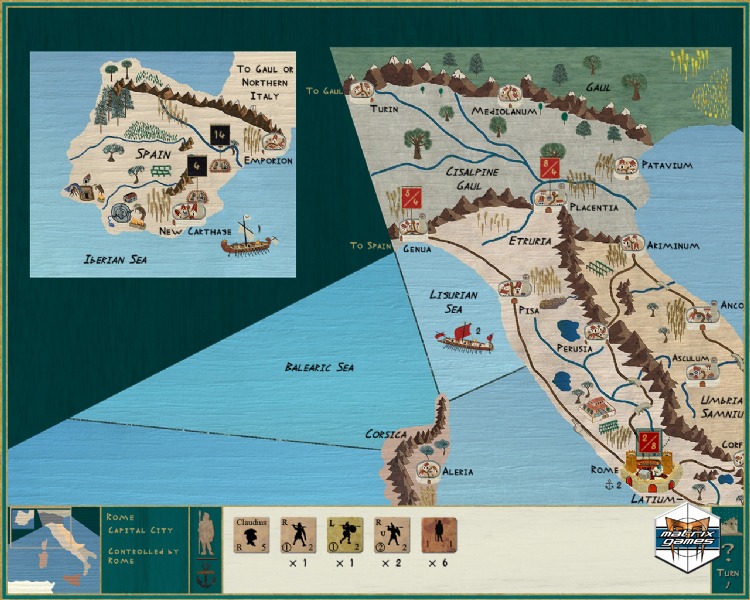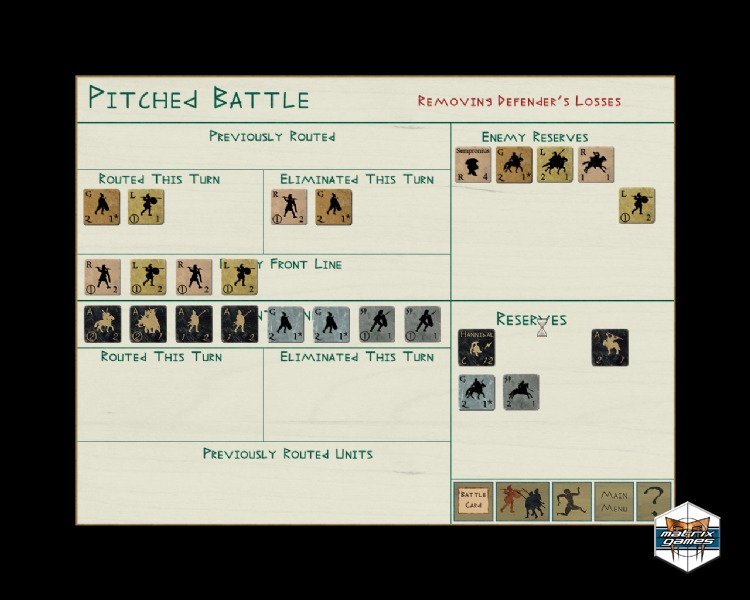Hannibal: Rome and Carthage
Oct 20, 2010 · peterb · 4 minute readGames
Oh, look, a beautiful and challenging strategy game.
Hannibal: Rome and Carthage is a gorgeous computer board game. Based, seemingly, on the board game [Hannibal: Rome and Carthage in the Second Punic War, 219-202 B.C.](http://boardgamegeek.com/boardgame/10914/hannibal-rome- and-carthage-in-the-second-punic-war), Hannibal is a unique little gem of a wargame.
For those who, like me, are merely amateur students of Roman history, the real Hannibal is something of a mystery. Clearly a general of legendary talents – his brilliant army-destroying trap at the Battle of Cannae alone would be enough to catapult him into the company of Alexander of Makedon, even before you think about what kind of balls it takes to march elephants over the Alps – the question in my mind has always been “Why didn’t he march on Rome? Why did he dork around in the south of Italy for all those years? What was the point?” Hannibal: Rome and Carthage, through the magic of game mechanics, tries to answer that question.
In the game, Hannibal is the most brilliant general in the world when in the field. The moment he is pinned down maintaining a siege, many of his advantages (represented in-game via action cards that provide him with incredible bonuses in battles) evaporate. Furthermore, Hannibal is fighting a war far from home, past the limit of the ancient world’s supply lines. Reinforcements from Carthage are hard-pressed to reach him, and are inadequate to replace his losses besides. In order to mount a serious challenge to Rome he has to capture cities in mainland Italy (as well as in the other theaters of the game). Capturing these Latin ally cities both reduces Rome’s (prodigious) ability to levy new troops, and makes some troops available to Carthage. The question is whether the player, as Carthage and Hannibal – you never get to play as Rome – can maintain his advantage long enough before losing so many troops to attrition that the Roman player overwhelms him with sheer numbers.

The game is stunningly beautiful. It looks hand-drawn, or hand-painted. I simply can’t recall the last time I’ve seen a tile-based war game that looked this good.
Battles in the game occur on land and at sea, in five different areas, or theaters: Italy, Spain, Northern Africa, Sicily, and Sardinia. Travel between theaters ranges from easy to treacherous depending on who holds what cities, the state of naval superiority, whether there are any intervening mountain ranges, and how far you are trying to march. On each turn, you activate generals, who collect troops and (hopefully) perform operations against the enemy, including sieges, field battles, and sea battles. At higher game levels, there is also work to be done convincing the Carthaginian Senate to reinforce the theaters that you want to be reinforced.
The turn structure is odd, and somehow satisfying. Each turn, you have a certain number of “activations”. You can use those to activate a general (or admiral, for sea operations). Each general may do as many things as he wants, although certain operations (such as laying siege to a city) may end his turn. Once a general ends his activation, he cannot be activated again for the rest of the turn.

Among the biggest drawbacks of the game is that the combat system is very, very opaque. Each army has an attack factor and a strength factor indicating how much damage it can do, and how much damage it can take. However, there’s no way to see any calculation showing why you won or lost, just that you did. So you know that the general has a bonus that is added into combat; you know that (for example) the defender in a city has a bonus that is added in as well. But you don’t see how any of these are applied. I generally hate having to sit there and calculate in war games, and that’s not what I’m begging for, but the fact is that since the attack and strength factors are on the tiles already, you’ve exposed part of what I need to know, but not all of it. The overall effect is that combat sometimes feels like playing that game where you shoot lasers into a covered table, trying to figure out where the mirrors are located. I’m not ashamed to say that I reloaded my first game several times when the world came crashing down around my ears, and I think the opaqueness of the combat resolution makes such behavior practically inevitable.
This is a difficult game: even on the easiest level, I think even experienced war-gamers are going to find this one to be quite a challenge. But this is as it should be. Hannibal, despite his genius, and despite the many Roman armies he destroyed, eventually lost.
Do you think you can do better than that? This is your chance to prove it.
Hannibal: Rome and Carthage in the Second Punic War by Forced March Games is [available from Matrix Games](http://www.matrixgames.com/products/388/details/ Hannibal:.Rome.and.Carthage.in.the.Second.Punic.War), for Windows only, for $39.99. A [free demo is available](http://www.matrixgames.com/products/388/dow nloads/Hannibal:.Rome.and.Carthage.in.the.Second.Punic.War).
Disclosure statement: Matrix games graciously provided Tea Leaves with a review copy of this game.